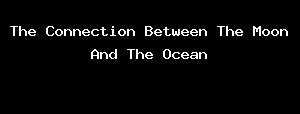JayKay
Business Person : I'm An Honest Person
Wants to meet Business Partners
Articles
404
Followers
24
profile/4914IMG_20200909_155545.jpg
Jaykay

The Connection Between The Moon And The Ocean
~3.5 mins read
The Connection Between The Moon And The Ocean
The alternating pattern of rising and falling sea level with respect to land is what we know as the tides. What causes this "motion of the ocean"? In one word, gravity. Specifically, the gravitational forces of the Sun and Moon.
The key to understanding how the tides work is understanding the relationship between the motion of our planet and the Moon and Sun. As the Earth spins on its own axis, ocean water is kept at equal levels around the planet by the Earth's gravity pulling inward and centrifugal force pushing outward.
However, the Moon's gravitational forces are strong enough to disrupt this balance by accelerating the water towards the Moon. This causes the water to 'bulge.' As the Moon orbits our planet and as the Earth rotates, the bulge also moves. The areas of the Earth where the bulging occurs experience high tide, and the other areas are subject to a low tide.
Water on the opposite side of Earth facing away from the Moon also bulges outward (high tide), but for a different and interesting reason: in reality, the Moon and the Earth revolve together around a common gravitational center between them, or center of mass. Here's a rough but helpful analogy: picture yourself swinging a heavy object attached to a rope around your body as you rotate. You have to lean back to compensate, which puts the center of mass between you and the object. With the Earth-Moon system, gravity is like a rope that pulls or keeps the two bodies together, and centrifugal force is what keeps them apart. Because the centrifugal force is greater than the Moon's gravitational pull, ocean water on the opposite side of the Earth bulges outward.
The same forces are at play as the Earth revolves around the Sun. The Sun's gravity pulls ocean water toward the Sun, but at the same time, the centrifugal force of the combined Earth-Sun revolution causes water on the opposite side of Earth to bulge away from the Sun. However, the effect is smaller than the Moon, even given the greater mass of the Sun (greater mass means greater gravitational force). Why? Simply because The Sun is so far away — over 380 times farther away from the Earth than the Moon.
Because the tides are influenced by both the Moon and the Sun, it's easy to see that when the Sun lines up with the Moon and the Earth, as during a New Moon or Full Moon (a configuration also called "syzygy", the tidal effect is increased. These are known as spring tides, named not for the season, but for the fact that the water "springs" higher than normal.
On the other hand, if the Sun and the Moon are 90 degrees apart in relation to an observer on Earth as during the First Quarter Moon or Third Quarter Moon (sometimes called half moons), then high tides are not as high as they normally would be. This is because despite its greater distance, the Sun's mass allows it to exert enough gravitational force on the oceans that it can negate some of the effects of the Moon's pull. This phenomenon of lower high tides is called a neap tide.
The height of the tides can also vary during the course of a month because the Moon is not always the same distance from the Earth. As the Moon's orbit brings it in closer proximity to our planet (closest distance within a moon cycle is called perigee), its gravitational forces can increase by almost 50%, and this stronger force leads to high tides. Likewise, when the Moon is farther away from the Earth (furthest distance is called apogee), the tides are not as spectacular.
Tides most commonly occur twice a day (diurnal). Tides can also occur as two high waters and two low waters each day (semi-diurnal). However, these periods do not happen at the same time each day. This is because the Moon takes slightly longer than 24 hours to line up again exactly with the same point on the Earth - about 50 minutes more. Therefore, the timing of high tides is staggered throughout the course of a month, with each tide commencing approximately 24 hours and 50 minutes later than the one before it.
There are many factors involved in predicting the tides. In addition to the motion of the Moon and Sun described above, timing of the tides are also affected by the Moon's declination (angular height above the equator), local geography of the coastline, topography of the ocean floor, and depth of the water, among other considerations. Thus, the tides can't be perfectly predicted solely by astronomical calculations that track the Sun and Moon. For greatest accuracy, tide prediction tables always integrate data from actual observation, often over a period of many years.
profile/4914IMG_20200909_155545.jpg
Jaykay

Benin City: Evidence That Nigeria Was Better Than London, Security, Hunger Etc
~1.2 mins read
Benin City: Evidence That Nigeria Was Better Than London, Security, Hunger Etc
Benin city when compare to London!!!
When the Portuguese first “discovered†the city in 1485, they were stunned to find this vast kingdom made of hundreds of interlocked cities and villages in the middle of the African jungle. They called it the “Great City of Beninâ€, at a time when there were hardly any other places in Africa the Europeans acknowledged as a city. Indeed, they classified Benin City as one of the most beautiful and best planned cities in the world.
In 1691, the Portuguese ship captain
Lourenco Pinto observed : “Great Benin, where the king resides, is larger than Lisbon; all the streets run straight and as far as the eye can see. The houses are large, especially that of the king, which is richly decorated and has fine columns. The city is wealthy and industrious. It is so well governed that theft is unknown and the people live in such security that they have no doors to their houses.â€
In contrast, London at the same time is
described by Bruce Holsinger, professor of English at the University of Virginia, as being a city of “thievery, prostitution, murder, bribery and a thriving black market made the medieval city ripe for exploitation by those with a skill for the quick blade or picking a pocketâ€.
The early foreign explorers’ descriptions of Benin City portrayed it as a place free of crime and hunger, with large streets and houses kept clean; a city filled with courteous, honest people, and run by a centralised and highly sophisticated bureaucracy.
what is the story now
Can we still claim these ?
Advertisement

Link socials
Matches
Loading...
